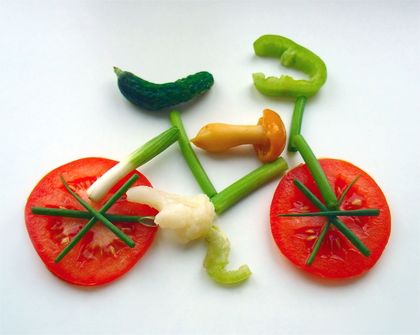How Fats, Proteins, and Carbs are Digested and Absorbed in the Body

Digestion is the process of breaking down food into simpler
parts. Generally the food we eat must be
digested into smaller parts so that it can be absorbed into the body and used within
the body. Fats are broken down and digested into fatty acids and glycerol; Proteins
are digested into amino acids; Carbohydrates are digested into simple sugars. Digestion requires mechanical and chemical
processes. An enzyme is a protein that speeds up a chemical reaction; digestive
enzymes speed up the decomposition of a food.
Food is chewed in the mouth, which breaks down the food into smaller
pieces for swallowing and assists in the speed chemical digestion. Chemical
digestion likewise starts in your mouth – saliva contains an enzyme called “amylase”
that begins breaking down carbohydrates.
When you swallow, the food travels down into the muscular tube
connecting your mouth to your stomach called the “esophagus.” The stomach is a muscular sac that performs
both mechanical and chemical digestion (Discovery Health, 2008).

Fats, Proteins, and Carbohydrates are macronutrients that provide
calories or energy. Nutrients are
substances needed for growth, metabolism, and for other body functions. Since “macro” means large, macronutrients are
nutrients needed in large amounts. Carbohydrates
are the body’s main source of fuel, Carbohydrates are needed for the central
nervous system, the kidneys, the brain, the muscles (including the heart) to
function properly. Carbohydrates can be
stored in the muscles and liver and later used for energy. We need protein for:
Growth (especially important for children, teens, and pregnant women); Tissue
repair; Immune function; Making essential hormones and enzymes; Energy when
carbohydrate is not available; and preserving lean muscle mass. We need fat for: Normal growth and development; Energy (fat is
the most concentrated source of energy); Absorbing certain vitamins (like
vitamins A, D, E, K, and carotenoids); and Providing taste, consistency, and
stability to foods (McKinley Health Center, 2008).
The Good Fats, The Bad Fats

The good fats are monounsaturated fats or polyunsaturated
fats that you find in healthy lean meats, plants, nuts, and olive oil. The fats considered bad for your system are
the saturated fats or trans-fats that are found in pastries, cheeses, butter,
and whole milk. Trans-fatty acids are polyunsaturated oils hardened by
hydrogenation and are in foods for instance fried chicken, doughnuts, which are
deemed unhealthy for our systems. The trans-fatty acids in these foods raise
our lipoprotein; our bad cholesterol levels and increases the risk of
Cardiovascular Disease and stroke (Sizer & Whitney, 2011).
Why is Fiber so Beneficial?

The American Dietetic Association suggests 20-35 grams of fiber daily, or about
two times higher than the average intake of about 14 to 15 grams (Sizer, F.
& Whitney, E., 2011).
Foods such as whole grains,
vegetables, legumes, and fruits offer important vitamins, minerals, and
phytochemicals, together with a healthy amount of fiber and little or no fat.
Benefits consist of: promotion of normal blood cholesterol
concentrations and reduced risk of heart disease, and control of blood
pressure. Diets high in fiber; however, and obesity. Two sources of fiber include: oatmeal and apples (Sizer, F. &
Whitney, E., 2011).
References:
Discovery Health, (2008). Digestion of fats, proteins, and
carbohydrates. Retrieved from: http://www.discoveryeducation.com/diabetes/pdf/Lesson2.pdf
on April 8, 2012
McKinley Health Center, (2008). Macronutrients: the
Importance of Carbohydrate, Protein, and Fat. Retrieved from: http://www.mckinley.illinois.edu/Handouts/macronutrients.htm
on April 8, 2012
Sizer, F. & Whitney, E. (2011). Nutrition: Concepts and Controversies (12th
ed.). Mason, OH: Cengage Learning
No comments:
Post a Comment